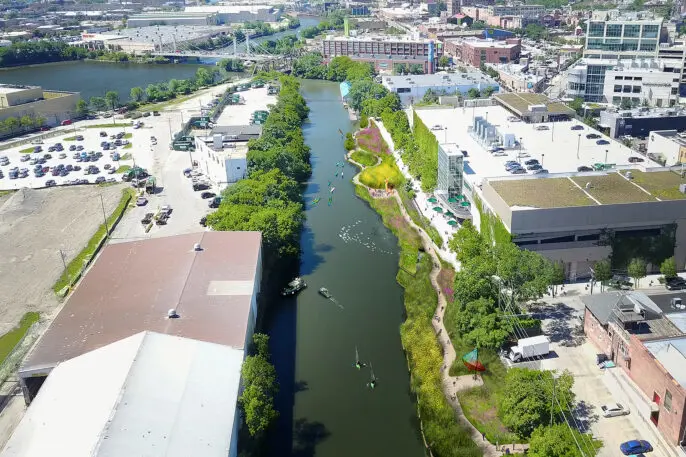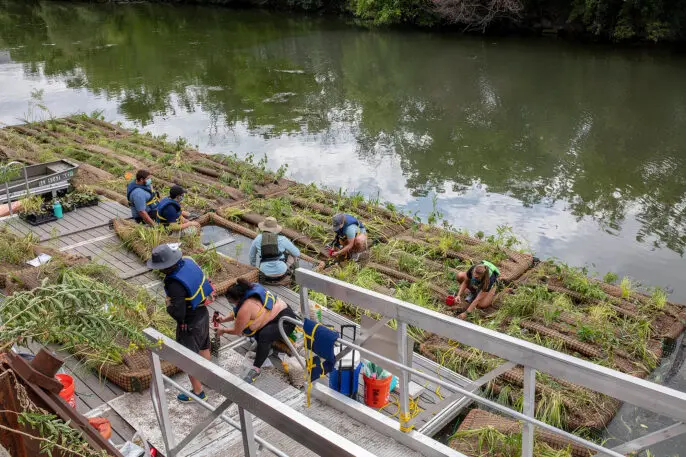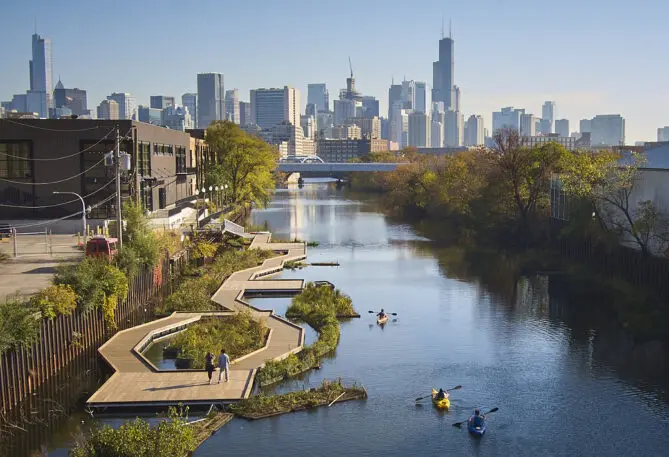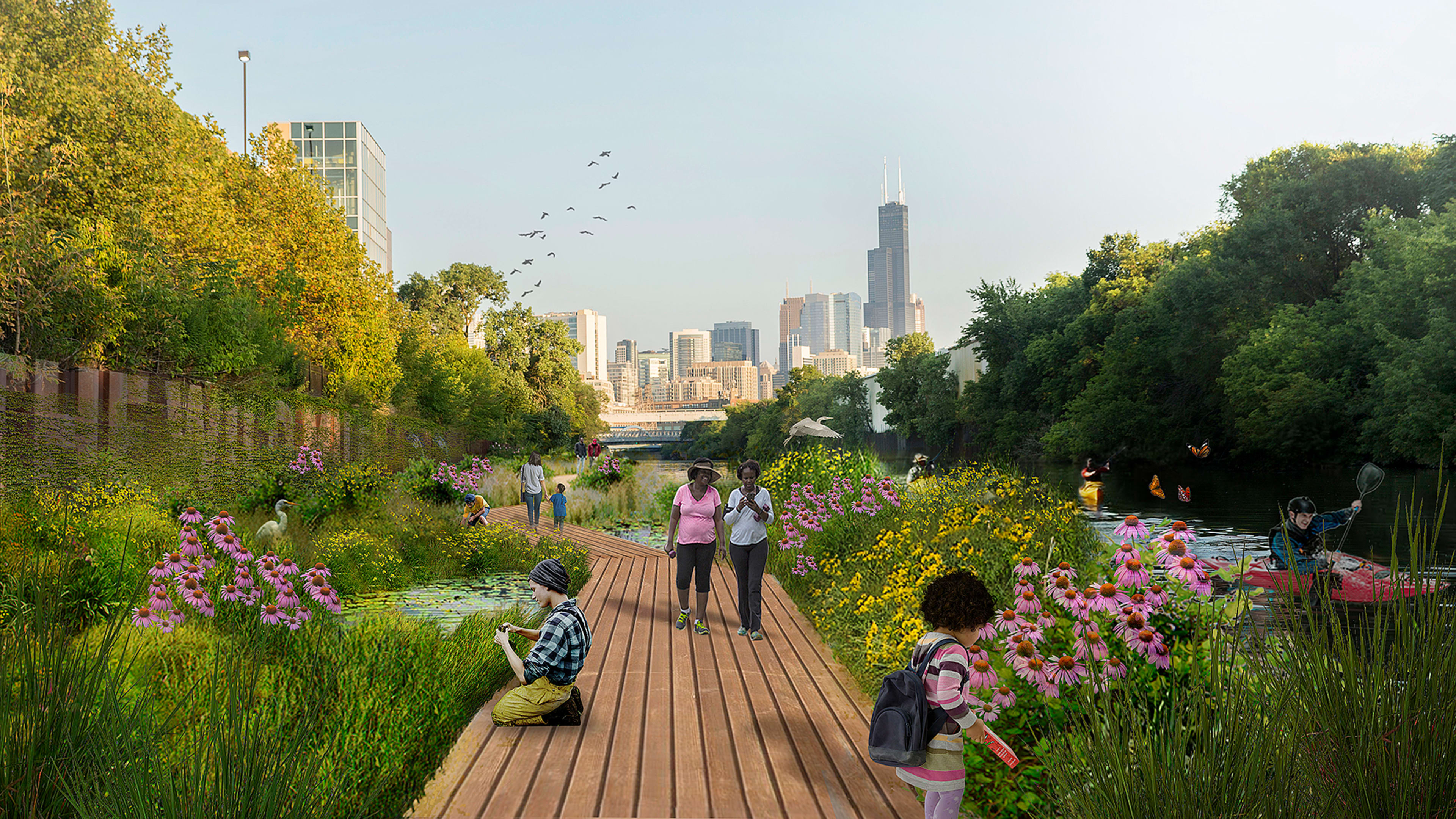The north branch of the Chicago River, just outside of the city’s downtown, was once lined with smoke-spewing factories, occupied by barges, and treated like little more than a convenient sewer. Its edges were straightened, and much of its life was drained in favor of efficient shipping.
Today, a remarkable transformation is underway. Long linear patches of wetlands are spreading along the channel’s edges, and docks have been built alongside as a kind of floating walkway. This is the first 400 feet of what’s being called the Wild Mile—a grassroots reinvigoration of a stretch of the river that has been off-limits to nearly all forms of life for decades.

Led by Urban Rivers, a nonprofit created to realize the project, the Wild Mile is a planned mile-long floating wetland and trail built on the river as it winds around Goose Island, just northwest of the city center. Thanks to a tax on urban development that helps fund open space, the project has received a significant amount of public funding to get started. As it expands, it has become a promising experiment in making public space out of areas most cities have turned their backs on.
Like many U.S. cities in the late 1800s and early 1900s, Chicago channelized much of its urban river, building straight, boat-friendly sides by piling plates of steel vertically along its edges. This infrastructural intervention eased commerce and industry but virtually eliminated the river habitat that lies along the shore. “So you have this massive infrastructure in place and everything in between it is basically unused,” says Nick Wesley, a cofounder of Urban Rivers. “It begs the question, what do we do with these spaces? They’re in some of the densest areas on the planet, and they cut through areas that have no connection to nature.”
The Wild Mile is trying to address both of those issues: increasing access to open space in the city, and improving the habitat that exists there.
The floating gardens are artificial wetlands, with native plants suspended in the water in a raft-like armature of marine-grade materials that provide space for plant roots to grow. Above the surface, the plants become habitat for insects, which then attracts birds. Below, the roots hang down in the water, absorbing pollutants and forming breeding grounds for fish. “Essentially, we’re trying to emulate the normal edge of a river system,” Wesley says.
The idea for the project took shape back in 2014. Wesley, along with Urban Rivers cofounders Zach Damato and Josh Yellin, had been interested in proving the potential of floating wetlands as a way to clean up water in the river and provide wildlife habitat—a seemingly straightforward proposition.

“We were like, if no one else is going to do it, we will. It doesn’t seem that hard, it just seems like someone’s got to focus on it for a while,” says Wesley. “So we expected we’ll submit a permit to the city, three months later we’ll get it, we’ll raise some money, and put it in.”
The reality was much more complicated. The waterway is technically under federal jurisdiction and overseen by the Army Corps of Engineers. Any work on the water would also require approvals from the state’s environmental agency as well as the city’s transportation department. To get those approvals, the group realized they needed to go pro. Urban Rivers started reaching out to architects in the Chicago area. “We talked to a bunch, but the only one who was really interested in helping was SOM [Skidmore Owings & Merrill],” Wesley says. “They got it immediately, before we had really done anything. They got the vision and the need for this.”
Plans and drawings were created, and the idea evolved into a formal proposal. After two and a half years of effort, Urban Rivers got the permits it needed to start building out the Wild Mile in earnest. Then the organization began looking for more substantial support. It got a grant from Patagonia, launched a Kickstarter crowdfunding campaign, and started creating partnerships with whomever was interested. There was some help from the Shedd Aquarium and some initial buy-in from a private school located along that section of the river. In 2017, a test strip of wetland was installed near the school, accessible only by kayak, and Urban Rivers began collecting data on the wetland’s impacts.
As the plan became more official the scope also expanded, from just planting wetlands to building walkways alongside them. In 2019, Urban Rivers, the City of Chicago, SOM, and several partners released a framework plan for the Wild Mile, plotting out how it could be implemented and what impact it could have on the city and the river. The first floating walkway was planned in 2020, with about $1.6 million in funding from the city’s tax on development, plus other raised funding. Pandemic delays pushed the timeline back a bit, and the first section was eventually installed last fall. It opened to the public this spring.

The 400-foot-long walkway is roughly shaped like a skeleton key, with floating wetlands along its edges and in the center of a loop at the end. There’s a put-in area at the edge for kayakers and an accessible walkway that leads up to the street level. In addition to insects, birds and fish, wildlife such as muskrats and beavers have already been seen at the wetlands. Wesley says the next phase of the project will be to extend the wetlands and walkways northward, adding more access points where people can come down to the river’s edge or even get kayaks into the water.
Wesley says the growing Wild Mile should be seen as a model for other cities with underutilized rivers. With their industrial uses fading, these spaces are finding renewed interest from urban developers. One major project is rising near the Wild Mile—a 487-unit residential complex that will have a retail component—and a connection to a future section of the floating wetland is included in its plans. Wesley says other developments in the area have supported the Wild Mile by pledging to make their riverfront properties into access points, or at least by not standing in the project’s way.
Urban Rivers is hopeful that the full mile of the Wild Mile can be built out in the next few years, with ongoing financial support from the city’s development tax, grants, and other fundraising. “We’re still knocking on doors,” says Damato.
Wesley is confident the experiment is working—in terms of increasing wildlife habitat in this once-industrial waterway, but also in reframing what an urban river can be.
“As land values increase, as open space becomes more scare, I think this will be a really clear way to create public space in cities,” Wesley says. “Hopefully, we make this something that is so commonplace, and such a no-brainer, that people forget that it ever was different.”
Recognize your brand’s excellence by applying to this year’s Brands That Matter Awards before the early-rate deadline, May 3.
